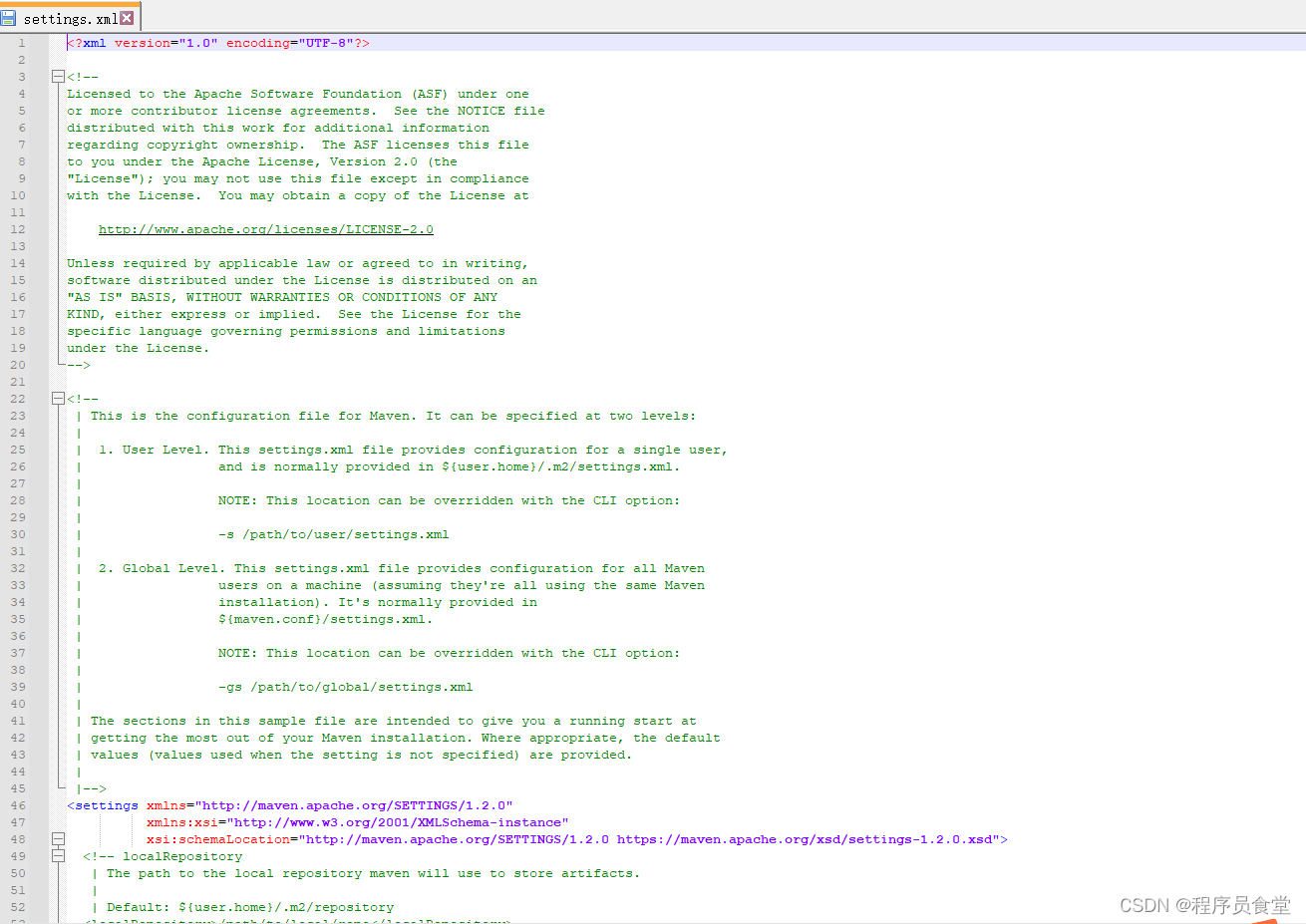settings.xml 文件介绍
settings.xml 是 Maven 的配置文件,它允许你自定义 Maven 的行为,比如设置仓库、代理、认证信息等。在 Maven 3.9 中,settings.xml 的结构和内容可能与之前的版本相似,但可能会有一些小的改进或变化。下面我们以3.9.6版本介绍。
首先打开maven的解压目录的 conf 文件夹

打开settings.xml文件

下面我们一个配置一个的过
settings.xml 配置项
总配置项(简化)
<settings xmlns="http://maven.apache.org/SETTINGS/1.0.0"
xmlns:xsi="http://www.w3.org/2001/XMLSchema-instance"
xsi:schemaLocation="http://maven.apache.org/SETTINGS/1.0.0
https://maven.apache.org/xsd/settings-1.0.0.xsd">
<localRepository/>
<interactiveMode/>
<usePluginRegistry/>
<offline/>
<pluginGroups/>
<servers/>
<mirrors/>
<proxies/>
<profiles/>
<activeProfiles/>
</settings>localRepository
设置本地仓库的位置。
示例:
<localRepository>D:\repository\.m2</localRepository>interactiveMode
设置Maven是否应该以交互模式运行。默认值为true,表示Maven在需要时会提示用户输入。如果设置为false,Maven将使用默认值或基于其他设置的值。
示例:
<interactiveMode>true</interactiveMode>offline
<offline>设置Maven是否应该尝试联网执行构建。默认值为false。当由于网络设置或安全因素,构建服务器不能连接远程仓库时,这个设置非常有用。
示例:
<offline>false</offline>pluginGroups
定义插件组。<pluginGroups>允许定义额外的插件组,这些组在解析插件时会被搜索。默认情况下,Maven会自动添加org.apache.maven.plugins和org.codehaus.mojo。
示例:
<pluginGroups>
<pluginGroup>org.mortbay.jetty</pluginGroup>
</pluginGroups>servers
<servers>用于定义服务器配置,如认证信息,这些信息通常不应该在pom.xml中配置,以避免安全问题。
示例:
<interactiveMode>true</interactiveMode>mirrors
配置镜像站点,用于加速 Maven 下载。
配置阿里云镜像示例:
<mirrors>
<mirror>
<id>alimaven</id>
<name>aliyun maven</name>
<url>http://maven.aliyun.com/nexus/content/groups/public/</url>
<mirrorOf>central</mirrorOf>
</mirror>
</mirrors>proxies
<proxies>用于配置网络代理,当Maven需要通过代理服务器连接外部网络时使用。
示例:
<proxies>
<proxy>
<id>optional</id>
<active>true</active>
<protocol>http</protocol>
<username>proxyuser</username>
<password>proxypass</password>
<host>proxy.host.net</host>
<port>80</port>
<nonProxyHosts>local.net|some.host.com</nonProxyHosts>
</proxy>
</proxies>profiles
<profiles>定义了一组构建配置文件,每个<profile>可以包含不同的设置和插件组。<activation>子元素定义了激活该配置文件的条件。<activeProfiles>列出了需要激活的配置文件ID。
示例:
<profiles>
<profile>
<id>tsetRepositories</id>
<repositories>
<repository>
<id>tset</id>
<url>http://maven.aliyun.com/nexus/content/groups/public/</url>
<releases>
<enabled>true</enabled>
</releases>
<snapshots>
<enabled>true</enabled>
</snapshots>
</repository>
</repositories>
</profile>
</profiles>activeProfiles
指定默认激活的配置文件。
示例:
<activeProfiles>
<activeProfile>testRepositories</activeProfile>
</activeProfiles>注意
settings.xml 文件通常位于你的用户目录下
在 Windows 上可能是 C:\Users\username
在 macOS 或 Linux 上可能是 ~/.m2
可以在命令行中使用 -s 参数指定一个不同的 settings.xml 文件。
